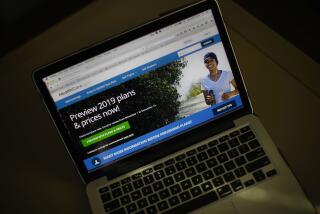Young May Be in for Surprise: Health Costs
CRYSTAL CITY, Va. — At 21, Mike Purvis feels invulnerable. And why not? The lanky young man has not been to a doctor in seven years.
“The last time was when I busted my knee open,” Purvis said with a smirk.
Back then, he was covered by his father’s health insurance policy. But that’s no longer the case now that he is a working adult, clocking more than 40 hours a week as an assistant delicatessen manager.
And it doesn’t bother Purvis to go uninsured. He is more concerned about scraping up money for car insurance.
“I’m young and healthy. I don’t have a need for a doctor--or a dentist,” he said. “Requiring me to pay? That stinks.”
Yet young adults like Purvis will almost certainly take a direct hit in their pocketbooks under virtually any kind of health care reform that Congress enacts. And most seem blithely unaware.
“These are mostly people in their first jobs,” said Harvard University professor Robert J. Blendon, a public opinion expert on health reform. “They’re trying to buy cars and houses. They’re less active in following public affairs.”
Of the nation’s 38 million uninsured people, more than half are under age 30, according to Census Bureau statistics. Other data show that those between age 21 and 24 are 32% more likely to be uninsured than those in all other age groups.
But under both President Clinton’s plan and the leading Republican alternative proposal, everyone must buy health insurance, just as car insurance is mandatory in many states.
And for the majority of young people, that could mean hundreds of dollars a year in new, out-of-pocket expenses--and perhaps quite a bit more for some, depending on their individual circumstances.
Those hardest hit will be youths like Purvis who have no insurance, although hefty premium increases may also be in store for youths who already have coverage. Insurers now typically charge older people much higher rates than young people--one of many industry practices that likely will be banned.
The result would be a new pricing system in which everyone--young and old, sick and well--pays the same rates. So the cost will go up for young people as rates drop for those who are older.
The blow of higher costs theoretically would be softened by other revisions intended to bring down the overall price of health insurance. Plans to impose a standard insurance claims form, for instance, are intended to cut administrative costs by billions of dollars a year, with the savings expected to lead to lower insurance rates.
Insurance costs could further drop if, as many propose, most consumers are pooled into vast regional insurance-purchasing “alliances” that can command high-quality services as well as low prices.
Also, any government-imposed requirement for individuals to carry health insurance is likely to be accompanied by subsidies for the indigent and for low-wage earners.
It’s impossible to say how much young people would have to pay until details are worked out on the dozen or so health care reform proposals being floated in Congress. But Clinton’s reform agenda, the key components of which are still alive, can serve as a guide.
Because about 85% of Americans with private health insurance get it through the workplace, the President wants to build on that system to achieve his one abiding goal: affordable lifetime coverage for all Americans, with a comprehensive set of benefits.
Under what is called an employer-and-individual mandate, all employers must pay at least 80% of a full-time worker’s insurance premiums. Individual employees are to pay the rest, but they would not have to pay more than 3.9% of their wages. Similarly, employer contributions would be capped at 7.9% of payroll. For part-time workers, payments would be calculated on a pro-rated basis.
The Clinton plan would provide subsidies to small firms with low payrolls. But many members of Congress would prefer to target subsidies not just at small businesses but at all low-income workers, including those at large firms.
Administration analysts estimate that if the major principles of the President’s plan are adopted, annual premiums would be about $4,200 for the average family policy and about $1,900 for an individual. Of that amount, a family’s premium payments would be about $840 a year, without subsidies, and an individual’s cost would be about $380 a year.
“By and large,” Clinton said last month, “the people who will pay more are people who aren’t paying anything now (and) people who have only very bare-bones coverage now. And young single workers will pay more so that older people can pay less and we have a large community rating. Otherwise, most other people will pay the same or less.”
Will young people rebel at such a new expense--even if it gives them the peace of mind of having solid health coverage?
“They certainly are vulnerable to a hit in the pocketbook,” Blendon said. “If their insurance goes up $54 a month, they’ll really know it.”
It may come down to their marital status, he added. In a survey of the uninsured in Massachusetts, published in 1992, Blendon found that 83% of uninsured families--but only 24% of uninsured single people--said they would be willing to buy coverage if just 30% of the cost were subsidized.
Administration officials concede that they have not gotten the message across, especially to the young, that everyone must pay their “fair share” under the proposal. But it isn’t for lack of trying.
When First Lady Hillary Rodham Clinton appeared earlier this month on the “Larry King Live” television talk show, a 21-year-old college student caller wanted to know “what the burden is going to be to my generation in order to support your generation’s social health care plan.”
Looking straight into the camera, the First Lady responded: “I’m glad you’re healthy. But, you know, you could have a car accident. You could wake up next week and find a lump somewhere on your body that would take you to the doctor. I have met countless 21-, 22-year-olds who also thought they were immortal--only to find that, along with the rest of us, health care and all of its problems is no respecter of age.”
She added: “And I hope that you will understand that by your not being insured, if you have an accident, if you have an illness strike you, the rest of us pay. That’s not fair either.”
Uwe Reinhardt, a Princeton University health economist, agreed. Young people, he said, “live cheaply and recklessly--and then later in life they throw themselves at the mercy of the court.”
True, serious diseases among young people are rare, but the prevalence of accidents and pregnancies is high--conditions that support the argument for having health insurance, said Diane Rowland, who heads the Washington office of the Kaiser Family Foundation. “So we’re not asking just the healthy people who will never need it to buy insurance,” she said.
The debate is likely to heat up, especially among the young, now that the Robert Wood Johnson Foundation, a Princeton, N.J.-based health care philanthropy, has given $2.8 million to the Rock The Vote Education Fund--a Los Angeles organization that promotes youth participation in the political process.
The grant is intended to support a range of activities to inform young people about the health care debate.
“Our view,” said Nicholas Butterworth, executive director of the fund, “is that young people are going to have to pay for health care reform, or they will have to pay for unrestrained health care spending without reform.”
The fund plans to produce a 40-page booklet and various public service announcements, as well as three nationally televised specials to be aired on youth-oriented networks such as MTV.
The nonprofit organization’s research shows that 27% of those between age 18 and 24 are uninsured--twice the rate for those between age 45 and 64. It also found that 22% of youths had an illness or injury that needed care but went untended because of the high cost and a lack of insurance coverage.
“There’s an awful lot of young people who feel that some kind of health reform is a good idea,” said Rob Nelson, co-founder of Lead or Leave, a Washington-based organization that also promotes youth involvement in the political process.
“But the question is,” he added, “is health care reform going to be paid for in a way that’s fair to all generations?”
That question was on the minds of many young workers interviewed here recently at the vast Pentagon City Mall, just across the river from Washington.
“I think it’s a good idea that all people have health insurance. But it depends on how much the cost will be,” said Stacey LaFleur, 22, a recent college graduate who is a sales clerk at a skin care boutique.
Maurice Haynes, 21, a music store employee, already has plans for the day he gets health insurance coverage. “I’m going to see a dentist,” he said.
Haynes said he has lived with seven cavities for more than a year. All he has been able to afford was a cleaning, which cost $47.
“So, yeah, I’d buy insurance,” Haynes said. “I don’t mind paying--as long as it isn’t outrageous.”
His notion of an affordable premium: $5 a month. “At most, $20,” he said.
More to Read
Sign up for Essential California
The most important California stories and recommendations in your inbox every morning.
You may occasionally receive promotional content from the Los Angeles Times.










